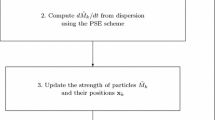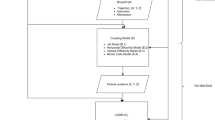Abstract
The random walk particle tracking (RWPT) method is compared with the Eulerian methods in investigating pollutant transport in depth-averaged flows. As a typical representative of the Eulerian model with high performance, the MacCormack scheme with Total Variation Diminishing modification (TVD-Mac) is selected for comparison. Solute concentration is simulated in four case studies. First, both numerical models have been tested in two idealized cases and compared against analytical solutions. Numerical dissipation is observed for TVD-Mac model where the concentration changes abruptly, especially under the circumstances of low resolution and misalignment between the flow direction and grid orientation. On the contrary, simulations by the random walk model achieve higher accuracy in both cases and are free of fictitious oscillations in the vicinity of sharp concentration gradients. Then, the solute oscillation along a one-dimensional hypothetical tidal estuary is simulated, with the RWPT accurately conserving mass and suffering less numerical diffusion compared with the Eulerian method. Finally, the process of pollutant transport in a Yangzte River reach is predicted by the RWPT. The longitudinal dispersion coefficient DL is calculated accordingly. It is compared favorably with the theoretical/empirical formulae, indicating the validity of the RWPT in solving complex natural problems.
Similar content being viewed by others
References
Dortch Mark S. Advances in water quality modeling in the coastal environment [M]. Elsevier Oceanography Series, 2003, 67: 491–503.
Liang D., Falconer R. A., Lin B. Comparison between TVD-MacCormack and ADI-type solvers of the shallow water equations [J]. Advances in water resources, 2006, 29(12): 1833–1845.
Mingham C. G., Causon D. M., Ingram D. M. A TVD MacCormack scheme for transcritical flow[C]. Proceedings of the Institution of Civil Engineers-Water and Maritime Engineering. Thomas Telford Ltd, 2001, 148(3): 167–175.
Salamon P., Fernàndez-Garcia D., Gómez-Hernández J. J. A review and numerical assessment of the random walk particle tracking method [J]. Journal of Contaminant Hydrology, 2006, 87(3-4): 277–305.
Benkhaldoun F., Elmahi I., Seai M. Well-balanced finite volume schemes for pollutant transport by shallow water equations on unstructured meshes[J]. Journal of Computational Physics, 2007, 226(1): 180–203.
Liang D., Lin B., Falconer R. A. Simulation of rapidly varying flow using an efficient TVD–MacCormack scheme[J]. International journal for numerical methods in fluids, 2007, 53(5): 811–826.
Liu Z., Chen Y., Zhu D. Study on the concentration distribution in a trapezoidal open-channel flow with a side discharge [J]. Environmental Fluid Mechanics, 2007, 7(6): 509–517.
Liang D, Wu X. A random walk simulation of scalar mixing in flows through submerged vegetations[J]. Journal of Hydrodynamics, 2014, 26(3): 343–350.
Barber R. W, Volakos N. P. Modelling depth-integrated pollution dispersion in the Gulf of Thermaikos using a Lagrangian particle technique [J]. WIT Transactions on Ecology and the Environment, 2005, 80.
Perianez R. A particle-tracking model for simulating pollutant dispersion in the Strait of Gibraltar [J]. Marine Pollution Bulletin, 2004, 49(7-8): 613–623.
Liang D., Wang X., Falconer R. A. et al. Solving the depth-integrated solute transport equation with a TVD-MacCormack scheme [J]. Environmental Modelling & Software, 2010, 25(12): 1619–1629.
Wu X., Liang D. On the accuracy of the random walk simulation of pollutant dispersion [C]. Second Conference of Global Chinese Scholars on Hydrodynamics, 2016.
Ye L., Cai Q., Liu R., et al. The influence of topography and land use on water quality of Xiangxi River in Three Gorges Reservoir region [J]. Environmental Geology, 2009, 58(5): 937–942.
Scholz-Starke B., Ottermanns R., Rings U. et al. An integrated approach to model the biomagnification of organic pollutants in aquatic food webs of the Yangtze Three Gorges Reservoir ecosystem using adapted pollution scenarios [J]. Environmental Science and Pollution Research, 2013, 20(10): 7009–7026.
Kashefipour S. M., Falconer R. A. Longitudinal dispersion coefficients in natural channels [J]. Water Research, 2002, 36(6): 1596–1608.
Fuat Toprak Z., Savci M. E. Longitudinal dispersion coefficient modeling in natural channels using fuzzy logic [J]. CLEAN–Soil, Air, Water, 2007, 35(6): 626–637.
Etemad-Shahidi A., Taghipour M. Predicting longitudinal dispersion coefficient in natural streams using M5′ model tree [J]. Journal of hydraulic engineering ASCE, 2012, 138(6): 542–554.
Wang Y. F., Huai W. X., Wang W. J. Physically sound formula for longitudinal dispersion coefficients of natural rivers[J]. Journal of Hydrology, 2017, 544: 511–523.
Fischer H. B. Longitudinal dispersion and turbulent mixing in open-channel flow [J]. Annual Review of Fluid Mechanics, 1973, 5(1): 59–78.
Elder J. W. The dispersion of marked fluid in turbulent shear flow [J]. Journal of fluid mechanics, 1959, 5(4): 544–560.
Li X., Liu H., Yin M. Differential evolution for prediction of longitudinal dispersion coefficients in natural streams [J]. Water resources management, 2013, 27(15): 5245–5260.
Sattar A. M. A., Gharabaghi B. Gene expression models for prediction of longitudinal dispersion coefficient in streams [J]. Journal of Hydrology, 2015, 524: 587–596.
Toprak Z. F., Cigizoglu H. K. Predicting longitudinal dispersion coefficient in natural streams by artificial intelligence methods [J]. Hydrological Processes: An International Journal, 2008, 22(20): 4106–4129.
Lin M. Y. Deterministic particle tracking simulation of pollutant discharges in rivers and estuaries [J]. Environmental Fluid Mechanics, 2018, 18(5): 1143–1166.
Acknowledgement
This work was supported by the Open Research Fund Program of State key Laboratory of Hydroscience and Engineering, Tsinghua University (Grant No. sklhse-2019-B-02)
Author information
Authors and Affiliations
Corresponding author
Additional information
Project supported by the National Natural Science Foundation of China (Grant No. 51809219), the Royal Academy of Engineering UK-China Urban Flooding Research Impact Programme (Grant No. UUFRIP\100051) and the Ministry of Education and State Administration of Foreign Experts Affairs 111 Project (Grant No. B17015).
Biography: Xue-fei Wu (1987-), Female, Ph. D., Associate Professor
Rights and permissions
About this article
Cite this article
Wu, Xf., Liang, D. Study of pollutant transport in depth-averaged flows using random walk method. J Hydrodyn 31, 303–316 (2019). https://doi.org/10.1007/s42241-018-0105-7
Received:
Revised:
Accepted:
Published:
Issue Date:
DOI: https://doi.org/10.1007/s42241-018-0105-7




